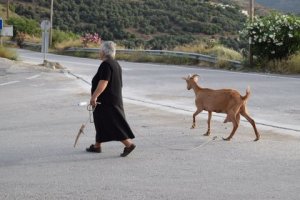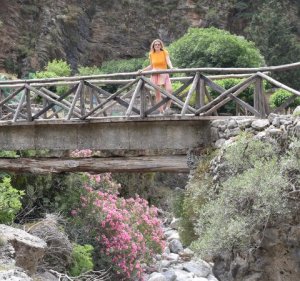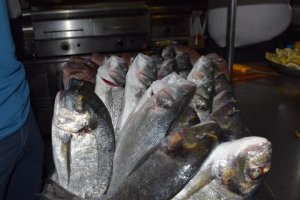
Stone bridge with oleanders
During our three-year tour in Budapest we visited Greece three times, our last trip was in Crete, its biggest island. The major natural beauty of Crete is the Samaria gorge, one of the longest gorges of Europe (the longest is the gorge du Verdon in France). It is a mostly easy hike, especially going down, and can be achieved by anyone who can walk from 5 to 95 years old! Let me walk you through it.
On a week day early in June we enjoyed Samaria almost alone. It was definitely not one of these days of the summer which will see up to 2,000 visitors trampling through. We arrived just after 8 a.m. in a bus of about 20 passengers from Paleochora.

Taking her goat to be milked, on the road to Xyloskalo
There were four options. Rush to the entrance of the park and get started immediately or before that take a photo on the rim, have a coffee or even breakfast, and/or go to the bathroom. The Swiss group rushed. We took our time. Officially it takes less than five hours to walk the gorge going down and we could not leave before 5:30 p.m., the departure time of the ferry back to Paleochora from the village at the end of the gorge, Agia Roumeli. We didn’t want to be stranded on the beach for four hours with 32-36 degrees Celsius (90F+).
The beginning of the hike features stairs of stone and wood for about five minutes, then it descends sharply with switchbacks among pine trees. We passed a few slow people and were alone on the trail. Then, an hour later, we rejoined the Swiss group and had to be careful avoiding their ski poles when passing them.
Ski poles, in my books, are meant for skiing or any winter sport involving snow. They have been designed to be planted in the snow. They cannot be planted in stones or hard rocks. Somebody must have missed playing the game stone-scissor-paper when they were young! Ski poles really don’t help when they slip on the hard surface of the rock. Quite the contrary, especially when suddenly they slip over a foot or two from the person they are supposed to help and are becoming a dangerous obstacle for other walkers. Some clever folks have equipped the end of their metallic ski poles with rubber. Some. Not the majority.
After a crowded 20 minutes of descent, as by enchantment, there was again not a soul in sight. The enchantment being partly explained by the fact that this park is very well maintained with many rest areas proposing natural fountains.
The entrance at Xyloskalo is marked number one and the exit is marked number 10. In between, the rest areas are almost every kilometer (900 to 1200 meters to be exact) except from one to two (1700m), eight to nine (3100m) and nine to 10 (1800m). This means that you may take two bottles of 500ml to start and refill every half hour or so. No need to load your backpack too much. Rest area number four is Agios Nikolai’s, Saint Nicolas, and this tiny church is actually open and not completely empty. It possesses a few religious images.
Rest area number seven is the most interesting since it is the old village of Samaria. The stone fountain has two spouts and there are many picnic tables in the shade of large trees. It is also slightly over the halfway point of the gorge, 7km out of 13. Most rest areas have toilets or WC. I don’t know if it is the same in summertime but they all had plenty of quality toilet paper inside. They are “Turk” toilets so be prepared to squat. In areas of intense passage I find this kind much more hygienic – the only problem here is that you need to throw your soiled paper in a bin (there is no flushing mechanism) and the rim of this bin is just about at nose level when you squat! Men will never realize this.

Stone bridge leading to Samaria
Rest area number eight, Perdika, was soon passed and then started my favorite part. The 3,100 meters between Perdika and Christos are magical. You start walking in the gorge, there is water finally in the river bed, dirt changes to sand, high cliffs are getting narrower, and pink oleanders, already ubiquitous during this hike, become even more numerous. Feet never get wet thanks to many cleverly arranged flat rocks, a few rickety wooden planks and real wooden bridges at the end. 500 meters past Christos you reach the “iron gates” which is where the cliffs are only three meters apart.
After exiting from the national park there are three more kilometers to reach the village on the beach and the ferry. There are many restaurants in the village serving real food like rabbit stew, as opposed to “non-real” food like nuggets – they are also on the menu. On the beach between Gigilos, Kyma, and the Agia Roumeli restaurant, there are plenty of long chairs to help wait for the ferry.

Choose it, weight it, eat it.
Back in Paleochora there are three good restaurants: Caravella, all about fish – you get to visit the kitchen to choose your own, Cape Crocodile, next to Caravella, looks fancier but not more expensive and very good, and finally for vegetarians, a restaurant which does not feel vegetarian, The Third Eye. It serves Greek, Indian, Asian, Mexican, and Arabic cuisine.
Enjoy!






